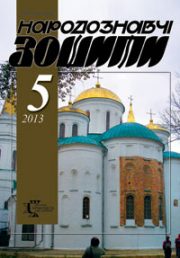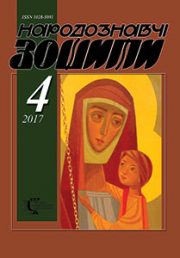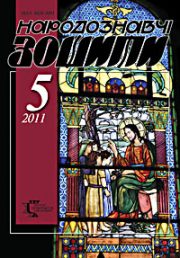The Ethnology Notebooks. 2022. № 4 (166), 752—763
UDK [929:271.4-725](477.83)
DOI https://doi.org/10.15407/nz2022.04.752
DULIBSKY FATHERS SHANKOVSKY — FROM «SERVICE TO THE FAMILY» TO «SERVICE TO THE PEOPLE»
TARAS Yaroslav
- ORCID ID: https://orcid.org/0000-0001-7241-9466
- Doctor of Historical Sciences, Professor,
- Institute of the Ethnology
- of the National Academy of Sciences of Ukraine,
- Head of the Department of Modern Ethnology,
- 15, Svobody Avenue, 79000, Lviv, Ukraine,
- Contacts: e-mail: etnomod@ukr.net
Abstract. The contribution to the spiritual and socio-political life of Galicia in the second half of the 19th — 20th years of the XX-th century is considered. Fathers Lev and Peter Shankovsky are parish priests of the village of Dulyby in the Stryi district. The purpose of the article is to find out, using the example of the Shankovsky fathers, how the Greek-Catholic noble environment went from «serving the family» to «serving the people», how it paid attention to its own people as a cultural national resource and got rid of the state mentality, the Poles were the carriers of it, overcame Muscoviteism became Ukrainized and contributed to raising the cultural and educational level of Ukrainians.
The task of the article is to highlight the origin of Fr. Lev Shankovsky, his merits in the field of organization of church, public and educational life in Duliby and Stry region as a parish priest, dean; his connections with Ivan Franko and other intellectuals of that time. The pastoral activity of Lev Shankovsky’s son Peter in Duliby is separately presented, how he became a conscious Ukrainian patriot, an active participant in national liberation struggles, thanks to Ivan Franko and Yevgeny Oles nytskyi.
The biography of Fathers Lev and Peter Shankovsky, who were pastors in the village of Duliby for 63 years, gave an opportunity to highlight the processes that took place in the Austro-Hungarian Empire: the Ukrainian national awakening, the search for national identity, to show their contribution to the development of the village, as thanks to the observance noble family traditions managed to raise nationally conscious, socially active grandchildren and great-grandchildren.
Keywords: Duliby, Stryshchyna (Stry region), Shankovsky family, Ivan Franko, Greek Catholic Church.
Received 13.07.2022
REFERENCES
- Kubijovych, V. (Ed.). (2000). Encyclopedia of Ukrainian Studies (Vol. 10, pp. 3600—4016). Lviv [in Ukrainian].
- Drit, T. (1903). Deans from the mountains. Lviv [in Ukrainian].
- Franko, I. (1913). Ruthenians. Types of Galician Ruthenians from the 1960s and 1970s. of the last century. Lviv [in Ukrainian].
- Olesnyts’kyj, Ye. (2007). Pages of my life. Stryj: Schedryk [in Ukrainian].
- Horak, R. Prebania in Falishy. (2014). Local history bulletin: Stryshchyna: History and modernity (Issue z). Stryj [in Ukrainian].
- Shankowsky, L. (1990). History outline of the Stryi region. The Stryi Region: Stryi, Skole, Bolekhiv, Dolyna, Rozhnitiv, Zhuravno, Zhydachiv, Mykolaiv n/Dn. (Vol. 1). Shevchenko Scientific Society; Stryishchyna Committee. New York [in Ukrainian].
- Krzywda coat of arms. Retrieved from: https://uk.wikipedia.org/wiki/Кривда_(герб) [in Ukrainian].
- Schematismus Universi Venerabilis Cleri Archidioeceseos Metropolitanae Graeco Catholicae Leopoliensis pro Anno Domini 1848. Retrieved from: https://dlibra.kul.pl/dlibra/publication/16160/edition/14606 [in Latin].
- Schematismus Universi Venerabilis Cleri Archidioeceseos Metropolitanae Graeco Catholicae Leopoliensis pro Anno Domini 1862. Retrieved from: https://dlibra.kul.pl/dlibra/publication/16162/edition/14621 [in Latin].
- Schematismus Universi Venerabilis Cleri Archidioeceseos Metropolitanae Graeco Catholicae Leopoliensis pro Anno Domini 1862. Retrieved from: https://dlibra.kul.pl/dlibra/publication/16170/edition/14668 [in Latin].
- Schematismus Universi Venerabilis Cleri Archidioeceseos Metropolitanae Graeco Catholicae Leopoliensis pro Anno Domini 1863. Retrieved from: https://dlibra.kul.pl/dlibra/publication/16171/edition/14674 [in Latin].
- Schematismus Universi Venerabilis Cleri Archidioeceseos Metropolitanae Graeco Catholicae Leopoliensis pro Anno Domini 1867. Retrieved from: https://dlibra.kul.pl/dlibra/publication/16175/edition/14692 [in Latin].
- (1882). Hof- und Staats-Handbuch der Osterreichisch-Ungarischen Monarchie fur 1882. Verlag: Wien, k. k. Hof- und Staatsdruckerei [in German].
- (1890). Dilo, 20 [in Ukrainian].
- (1893). Dilo, 266 [in Ukrainian].
- Central State Historical Archive of Ukraine in Lviv. F. 201. Op. 4a. Act 5328 [in Ukrainian].
- Sematizm Vsecestnogo Klira Gr. Kat. Mitropolital’noj Arhidiecezii L’vovskoj na Rok’ 1899. Retrieved from: https://dlibra.kul.pl/dlibra/publication/16341/edition/14667 [in Ukrainian].
- (1885). Dilo, 103 [in Ukrainian].
- (1898). Dilo, 243 [in Ukrainian].
- Sematizm Vsecestnogo Klira Gr. Kat. Mitropolital’noj Arhidiecezii L’vovskoj na Rok’ 1901. Retrieved from: https://dlibra.kul.pl/dlibra/publication/16343/edition/14679 [in Ukrainian].
- Blazejowskyj, D. (2004). Historical sematism of the Archeparchy of L’viv (1832—1944) (Vol. II: Clergy and Religious Congregations).Kyiv: Akademia.
- Taras, Ya. (2021). Vasyl Turchinyak as a builder of St. Yuriy church in the village Duliby of the Stryi district. The Ethnology Notebooks, 2, 342—354 [in Ukrainian].
- (1990). The Stryi Region: Stryi, Skole, Bolekhiv, Dolyna, Rozhnitiv, Zhuravno, Zhydachiv, Mykolaiv n/Dn. (Vol. 2). Shevchenko Scientific Society; Stryishchyna Committee. New York [in Ukrainian].







